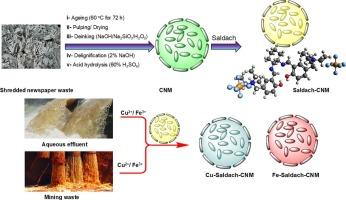Sustainable nanocellulose recovery from newspaper waste to fabricate a composite for sensing and scavenging copper and iron in aqueous effluents and mining wastes
IF 5.1
3区 工程技术
Q1 CHEMISTRY, APPLIED
引用次数: 0
Abstract
This study offers a straightforward and economical method for recovering cellulose nanoparticles (CNMs) from post-consumer newspaper trash in a sustainable manner. The recovered CNMs were subsequently utilized to fabricate a novel solid-state visual composite by immobilizing a newly synthesized fluorescent Schiff base ligand, (saldach(Et3N+PF6−)2, H2L) (Saldach ligand). Both the quick and on-site visual identification of Cu2+ and Fe3+ ions in aqueous solutions and the effective elimination of these heavy metal pollutants from mining effluent were proved by the resultant Saldach-composite. The Schiff base ligand, characterized by FTIR, NMR, and ESI-MS, exhibited selective binding toward Cu2+ and Fe3+ ions, leading to quantifiable UV–Vis spectroscopy. The morphology and composition of the CNMs and the Saldach-composite were investigated using SEM, TEM, DLS, XRD, and XPS analysis, confirming the successful incorporation of the Schiff base onto the CNM matrix. Additionally, the binding mechanism between the Saldach-composite and the target metal ions was clarified by the use of density functional theory (DFT) calculations. For the simultaneous detection and removal of Cu2+ and Fe3+ from mine waste, the developed solid-state visual composite presents a viable, economical, and ecologically friendly alternative, especially addressing the difficulties related to mining waste management.

从报纸废物中可持续回收纳米纤维素,以制造一种复合材料,用于感应和清除废水和采矿废物中的铜和铁
这项研究提供了一种简单而经济的方法,以可持续的方式从消费后的报纸垃圾中回收纤维素纳米颗粒(CNMs)。随后,利用回收的CNMs通过固定新合成的荧光希夫碱配体(saldach(Et3N+PF6−)2,H2L) (saldach配体)来制备新型固态视觉复合材料。所制备的saldach复合材料具有快速、现场目视识别水中Cu2+和Fe3+离子的能力,并能有效去除矿山废水中的重金属污染物。希夫碱配体通过FTIR、NMR和ESI-MS表征,表现出对Cu2+和Fe3+离子的选择性结合,导致可量化的UV-Vis光谱。利用SEM、TEM、DLS、XRD和XPS等分析手段对CNM和saldach -复合材料的形貌和组成进行了研究,证实了Schiff碱在CNM基体上的成功结合。此外,利用密度泛函理论(DFT)计算阐明了saldach -复合材料与靶金属离子的结合机理。对于同时检测和去除矿山废弃物中的Cu2+和Fe3+,所开发的固体视觉复合材料提供了一种可行的、经济的、生态友好的替代方案,特别是解决了与矿山废弃物管理相关的难题。
本文章由计算机程序翻译,如有差异,请以英文原文为准。
求助全文
约1分钟内获得全文
求助全文
来源期刊

Reactive & Functional Polymers
工程技术-高分子科学
CiteScore
8.90
自引率
5.90%
发文量
259
审稿时长
27 days
期刊介绍:
Reactive & Functional Polymers provides a forum to disseminate original ideas, concepts and developments in the science and technology of polymers with functional groups, which impart specific chemical reactivity or physical, chemical, structural, biological, and pharmacological functionality. The scope covers organic polymers, acting for instance as reagents, catalysts, templates, ion-exchangers, selective sorbents, chelating or antimicrobial agents, drug carriers, sensors, membranes, and hydrogels. This also includes reactive cross-linkable prepolymers and high-performance thermosetting polymers, natural or degradable polymers, conducting polymers, and porous polymers.
Original research articles must contain thorough molecular and material characterization data on synthesis of the above polymers in combination with their applications. Applications include but are not limited to catalysis, water or effluent treatment, separations and recovery, electronics and information storage, energy conversion, encapsulation, or adhesion.
 求助内容:
求助内容: 应助结果提醒方式:
应助结果提醒方式:


